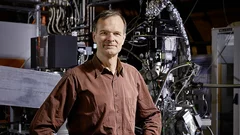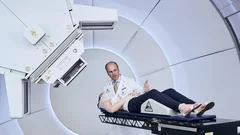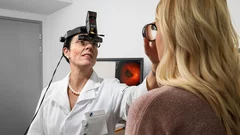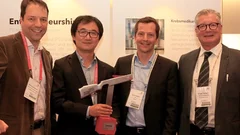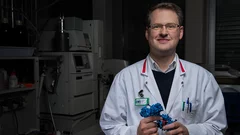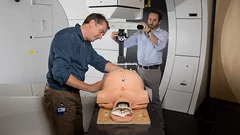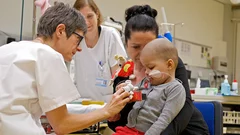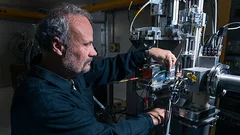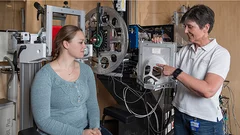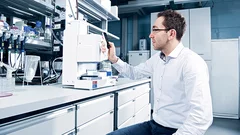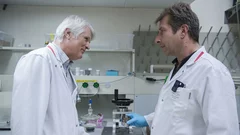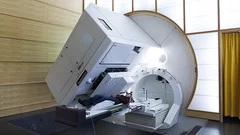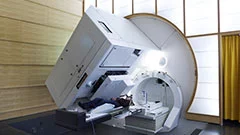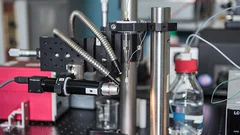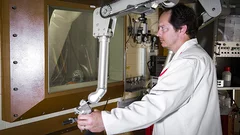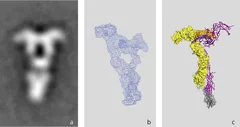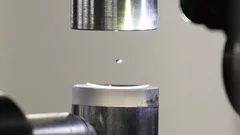Health Innovation
In the area of Health Innovation, several research groups at PSI are engaged in the study of fundamental questions regarding biology and cancer therapy. For example, they explore the structure of proteins – extremely complex biomolecules that are responsible for many different functions in organisms. Using PSI’s large research facilities, scientists also explore processes in biological tissue in order to fully understand their function and the development of specific diseases or deterioration processes. The ultimate goal is to find medicines that allow people to live as healthy a life as possible.
Patients with specific types of cancer are treated at the proton therapy facility on the PSI campus. Radiopharmaceuticals provide cancer treatments for very small tumours distributed throughout the body.
Find out more at: Overview Health Innovation
Imaging the inside of injection needles with neutrons
Researchers from the Paul Scherrer Institute PSI, the University of Basel and Roche have used neutron imaging to investigate why cool storage is crucial for syringes pre-filled with a liquid medication.
Light for biomolecules and super-fast processes
The 16th of May is the International Day of Light. The research carried out with light at PSI enables advances in biology and pharmacology and also promotes the development of new materials for data storage and new technologies for personalised medicine.
Opening: Advanced technology against cancer
With proton therapy, certain tumours can be irradiated with exceptional precision – while, the surrounding healthy tissue is optimally protected. In Switzerland, this kind of radiation therapy is only possible at PSI. In a joint project with the University Hospital Zurich and the University of Zurich, PSI has expanded its capacity with a state-of-the-art treatment facility: the new, 270-ton Gantry 3.
Lausanne-Villigen return
Nowhere in the world have so many ocular tumours been irradiated with protons as at PSI. But before the affected patients go to Villigen, they have to visit Lausanne: for pretreatment at the Jules Gonin Ophthalmic Hospital. The more than 30-year-long collaboration between the hospital and PSI is unique, and in most cases it saves the patient's diseased eye.
PSI spin-off GratXray wins Swiss Technology Award 2017
A spin-off from PSI has received this year's Swiss Technology Award: The young company GratXray is developing a new method for early diagnosis of breast cancer.
A new bio-robot
With a new method for modifying antibodies, Philipp Spycher, winner of a Founder Fellowship at the Paul Scherrer Institute PSI, wants to develop drugs that are more stable and, thus, have fewer side-effects.
Testing the Limits for the Patients' Benefit
Proton therapy is already a success story at the Paul Scherrer Institute PSI but researchers remain dedicated to making treatment faster and safer.
Big help for small children
When small children develop cancer, the whole family is affected. Staff at the Paul Scherrer Institute PSI’s Centre for Proton Therapy combine target-oriented proton beam irradiation and a caring, warm-hearted atmosphere to help these children.
Getting a Handle on Safety
Proton beams don’t just cure cancer. They can also damage healthy tissue. To make sure that this doesn’t happen, PSI’s Centre for Proton Therapy carries out over 350 safety tests a year. The results speak for themselves: several thousand patients have undergone proton irradiation treatment here in Villigen. There’s never been an accident.
Rays of hope for patients
For over 30 years, patients with a particular form of ocular tumour have been treated at PSI by means of proton irradiation. The tiny particles hit their target with millimetre precision, without endangering other structures of the eye. The irradiation facility OPTIS, developed at the PSI Center for Proton Therapy of the PSI, is a success story, considering that for more than 90 percent of the patients treated to date, the eye could be saved.
In start-up companies, getting it done is a matter of survival
A pharmaceuticals manager at Roche for a long time, now he is the founder of a biotech firm on the campus of the Paul Scherrer Institute PSI: Michael Hennig knows the trends in the medical sector. In this interview he explains why the medicine of the future needs the innovation power of publicly funded research, and why he chose to locate his start-up leadXpro so close to PSI.
In cold water
Martin Ostermaier wanted to break out of the comfort zone of science. Now, instead of pipettes, the biochemist is dealing with investors and patent law.
Added value for cancer patients
At the Paul Scherrer Institute PSI, cancer patients receive a treatment that is unique in Switzerland: proton therapy. This state-of-the-art form of radiation therapy against cancer has major advantages, compared to conventional irradiation, in terms of effectiveness and side-effects. The PSI has its own Center for Proton Therapy dedicated to this special treatment. Its pioneering work has not only helped several thousand patients, but also has fundamentally changed proton therapy worldwide.
In the focus of the protons
At the PSI, researchers work with radioactivity every day in order to develop advanced treatment methods for patients. Naturally, they take special safety precautions working with a material that decays. It's a race against time. To make sure everything functions smoothly, a dedicated work group takes care of the infrastructure.
Back to life
Doctors had discovered, behind Gabi Meier’s right eye, a tumour that surrounded the optic nerve. Only at the PSI was there still one possibility to treat the tumour in such a way as to preserve neighbouring structures and the eye. A few months after the proton treatment was over, I realised that I could see more and more, she said in an interview. “Just dimly, it’s true, but I could see! That was sensational!”
20 years of high-precision combat against cancer
On 25.11.1996, at the Paul Scherrer Institute PSI, the world’s first cancer patient was treated with a new irradiation method: the so-called spot-scanning technique for proton beams. What’s special about it: The beam has its effect only at the depth where the tumour is located; healthy tissue above and below it is preserved. The method, developed by PSI researchers, was a breakthrough at the time and quickly became a successful product.
Catching proteins in the act
Proteins are indispensable building blocks of life. They play a vital role in many biological processes. Researchers have now been able to show how the ultrafast processes by which proteins do their work can be studied with free-electron X-ray lasers such as SwissFEL at the Paul Scherrer Institute PSI. Free-electron X-ray lasers generate extremely short and intense pulses of X-ray light. Currently there are just two such facilities in operation, worldwide. The results were published in the scientific journal Nature Communications.
Designer nuclide for medical applications
Researchers at the PSI have for the first time used a cyclotron to produce the radionuclide scandium-44 in a quantity and concentration as needed for medical treatment. With that, they have achieved the first precondition for scandium-44 to be used one day for medical tests in hospitals.
To starve a tumour
PSI researcher Kurt Ballmer-Hofer is concerned with the question of how tumours could be starved by preventing the development of blood vessels. After 40 years of research that yielded many fundamental insights about the formation of blood vessels, one of the key molecules has been found; further research is expected to enable clinical applications.
Experiment in a hovering droplet
At the PSI, the exact structure of proteins is deciphered in the standard way, with X-rays. Now two PSI researchers have used a clever trick to advance this method further: Instead of pinning down the proteins, they are studying them within a levitating drop of liquid.

